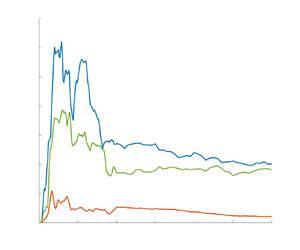Graphical abstract from Constante-Amores, C., Abadie, T., Kahouadji, L., Shin, S., Chergui, J., Juric, D., Castrejón-Pita, A.A. & Matar, O. 2023 Direct numerical simulations of turbulent jets: vortex-interface-surfactant interactions. J. Fluid Mech. 955, A42. doi:10.1017/jfm.2022.1056.
JFM Rapids
Spectral analysis of the evolution of energy-containing eddies
-
- Published online by Cambridge University Press:
- 16 January 2023, R1
-
- Article
-
- You have access
- Open access
- HTML
- Export citation
Locality of triad interaction and Kolmogorov constant in inertial wave turbulence
-
- Published online by Cambridge University Press:
- 23 January 2023, R2
-
- Article
- Export citation
Forced rotation enhances cylinder flow-induced vibrations at subcritical Reynolds number
-
- Published online by Cambridge University Press:
- 24 January 2023, R3
-
- Article
-
- You have access
- Open access
- HTML
- Export citation
JFM Papers
Improved assessment of the statistical stability of turbulent flows using extended Orr–Sommerfeld stability analysis
- Part of:
-
- Published online by Cambridge University Press:
- 12 January 2023, A1
-
- Article
-
- You have access
- Open access
- HTML
- Export citation
Data-driven kinematics-consistent model-order reduction of fluid–structure interaction problems: application to deformable microcapsules in a Stokes flow
-
- Published online by Cambridge University Press:
- 12 January 2023, A2
-
- Article
-
- You have access
- Open access
- HTML
- Export citation
On the rheology and magnetization of dilute magnetic emulsions under small amplitude oscillatory shear
-
- Published online by Cambridge University Press:
- 12 January 2023, A3
-
- Article
- Export citation
Numerical simulation of turbulent, plane parallel Couette–Poiseuille flow
-
- Published online by Cambridge University Press:
- 13 January 2023, A4
-
- Article
- Export citation
Two-scale solution for tripped turbulent boundary layer
-
- Published online by Cambridge University Press:
- 12 January 2023, A5
-
- Article
-
- You have access
- Open access
- HTML
- Export citation
A unified understanding of scale-resolving simulations and near-wall modelling of turbulent flows using optimal finite-element projections
-
- Published online by Cambridge University Press:
- 12 January 2023, A6
-
- Article
-
- You have access
- Open access
- HTML
- Export citation
Probing dissipation in spreading drops with granular suspensions
- Part of:
-
- Published online by Cambridge University Press:
- 12 January 2023, A7
-
- Article
-
- You have access
- HTML
- Export citation
Reinforcement-learning-based actuator selection method for active flow control
-
- Published online by Cambridge University Press:
- 12 January 2023, A8
-
- Article
- Export citation
Evolution of tornado-like vortices in three-dimensional compressible rectangular cavity flows
-
- Published online by Cambridge University Press:
- 13 January 2023, A9
-
- Article
- Export citation
Activity-induced migration of viscous droplets on a solid substrate
-
- Published online by Cambridge University Press:
- 13 January 2023, A10
-
- Article
- Export citation
Instability of a thin film of chemotactic active suspension
-
- Published online by Cambridge University Press:
- 13 January 2023, A11
-
- Article
-
- You have access
- Open access
- HTML
- Export citation
Turbulent entrainment in finite-length wind farms
-
- Published online by Cambridge University Press:
- 12 January 2023, A12
-
- Article
-
- You have access
- Open access
- HTML
- Export citation
The near-field shape and stability of a porous plume
-
- Published online by Cambridge University Press:
- 12 January 2023, A13
-
- Article
-
- You have access
- Open access
- HTML
- Export citation
Interpretable deep learning for prediction of Prandtl number effect in turbulent heat transfer
-
- Published online by Cambridge University Press:
- 12 January 2023, A14
-
- Article
-
- You have access
- Open access
- HTML
- Export citation
Strain self-amplification is larger than vortex stretching due to an invariant relation of filtered velocity gradients
-
- Published online by Cambridge University Press:
- 12 January 2023, A15
-
- Article
- Export citation
Attractors for the motion of a finite-size particle in a cuboidal lid-driven cavity
-
- Published online by Cambridge University Press:
- 13 January 2023, A16
-
- Article
-
- You have access
- Open access
- HTML
- Export citation
Almost extreme waves
-
- Published online by Cambridge University Press:
- 13 January 2023, A17
-
- Article
-
- You have access
- Open access
- HTML
- Export citation





























































































